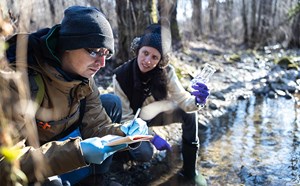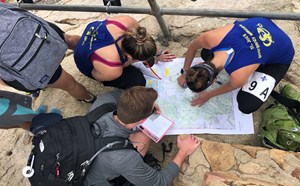
When the Desert Gets Too Hot to Handle: Heat Stroke in Staged Ultramarathon Running
by Nicole Prendergast, MD
Stanford Emergency Medicine PGY-4
Poor regulation of body heat, excessive exercise, and extreme weather conditions can each be dangerous. What if you combined all of these? Ultramarathon running pushes athletes to their mental and physical limits, however doing so in a desert with a heavy pack escalates this challenge. These runners push themselves to extremes risking medical emergencies, including heat stroke, as they adventure to the toughest terrain and environmental conditions in the world. I am a soon to be sports medicine fellow with a strong interest in wilderness medicine and endurance medicine and just returned from providing physician coverage for RacingThePlanet’s Namibia staged ultramarathon covering nearly 250 km where I got to witness this first-hand.
It was day-three of this seven-day event when the scalding midday heat reached oven level temperatures and the final 3 km of the stage held soft sandy terrain, protected from wind on all sides with mountains and small surrounding shrubbery. This was inaccessible via car. After a few days of racing, the medical team held a strong picture of each athlete’s performance. We had multiple runners make it slowly to the finish with a slow shuffling walk, despite comfortably running to the end in other stages. One of the other competitors stated “I feel like I am burning from the outside in.” This already was a concerning sign. We doused these runners in spray and encouraged electrolyte and water consumption. During this time, I heard that someone who was immediately behind these runners seemed to have dropped off. We sent out volunteers to search and received radio contact that there was a runner with an unsteady gait, vomiting and walking slowly despite only running in prior stages of the race. I advised the volunteer to stay with this runner. Ten minutes passed with no sign of the athletes. As the only physician at the finish and my concern for both heat related illness and exercise-associated hyponatremia (EAH) growing, I decided to run the kilometer towards them with my medical bag, evaluating others on the way. I found the runner walking slowly, with a stumbling and unsteady gait. He had vomited 4-5 times. He was confused, dizzy, weak and unable to follow the well-marked course. We found a small tree for shade in the exposed dry river bed, gave Zofran and sprayed him with water while fanning him to encourage evaporative cooling. After some rest and with incredible determination and grit, he was able to trek that remaining distance to the finish. We were able to grab salt tabs, water, some Coca-cola and a car with air conditioning and his symptoms improved.
Shortly after the race was truncated to avoid this inaccessible portion of the course.
Heat loss is controlled by communication between peripheral sensors in the skin and organs and the central nervous system. Heat illness is a spectrum of disease, ranging from mild, heat cramps, to severe, heat stroke. It occurs when the body is exposed to elevated temperatures or heat from muscular activity accumulates too fast leading to a rise in core temperature with responses at the systemic and cellular level. In these races, both are at play even though those with high levels of cardiopulmonary fitness can tolerate greater heat stress. Many factors can contribute to risk of heat illness with dehydration being of high concern in the desert leading to decreased sweat production. Altered mental status, including confusion, ataxia, vomiting, seizure, coma, combined with suspected or confirmed temperature greater than 40˚F is consistent with heat stroke. When strenuous exercise is a factor, this is further characterized as exertional heat stroke.
In this case, given the consistent appropriate fluid intake on previous days, lack of dyspnea, with the vomiting this was more likely heat stroke than severe EAH. Field treatment as in this case can be difficult given limited resources. Removal from heat, cessation of exertion, rehydration and aggressive cooling, however possible, is essential. Although cold water immersion is preferred, this is often not possible and evaporative cooling can be used with a mean cooling time between 40 and 68 minutes. Oral and intravenous administration of fluids have been shown to be equally effective in replenishing water deficiencies related to heat stress. History of fluid intake and urine output before and after assist in assessment of hydration status. Transport to a hospital should be consider if there is no improvement of mental status. If other medical history is unknown also consider hypoglycemia, CNS disease, infection, endocrine, or toxicological ingestion.
Other categories of heat-related illness seen during this race included:
- Heat edema: Swelling of extremities due to interstitial pooling of fluids
- Heat cramps: Painful involuntary muscle contractions during or immediately after exercise
- Heat syncope: loss of consciousness with spontaneous return to baseline mental status in setting of heat exertion
- Heat exhaustion: Elevated core temperature greater than 37˚C but less than 40˚C with thirst, weakness, discomfort, dizziness, syncope
Treatment similarly involves rapid cooling including getting out of the heat and minimizing muscular exertion. The prognosis is related to the degree and duration of the heat stress.
Maybe I am up next for this challenge in more ways than one, as a physician and a runner, only time will tell.
Source:
Lipman, Grant S., Flavio G. Gaudio, Kurt P. Eifling, Mark A. Ellis, Edward M. Otten, and Colin K. Grissom. “Wilderness Medical Society Clinical Practice Guidelines for the Prevention and Treatment of Heat Illness: 2019 Update.” Wilderness & Environmental Medicine 30, no. 4S (December 2019): S33–46.



